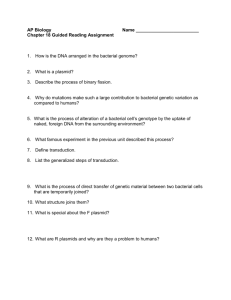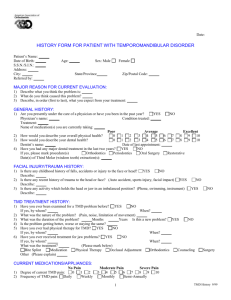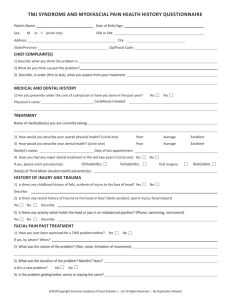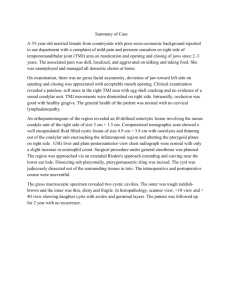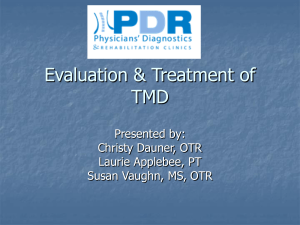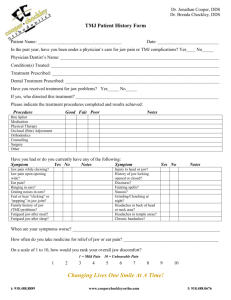September, 2011 - Clarkson University
advertisement
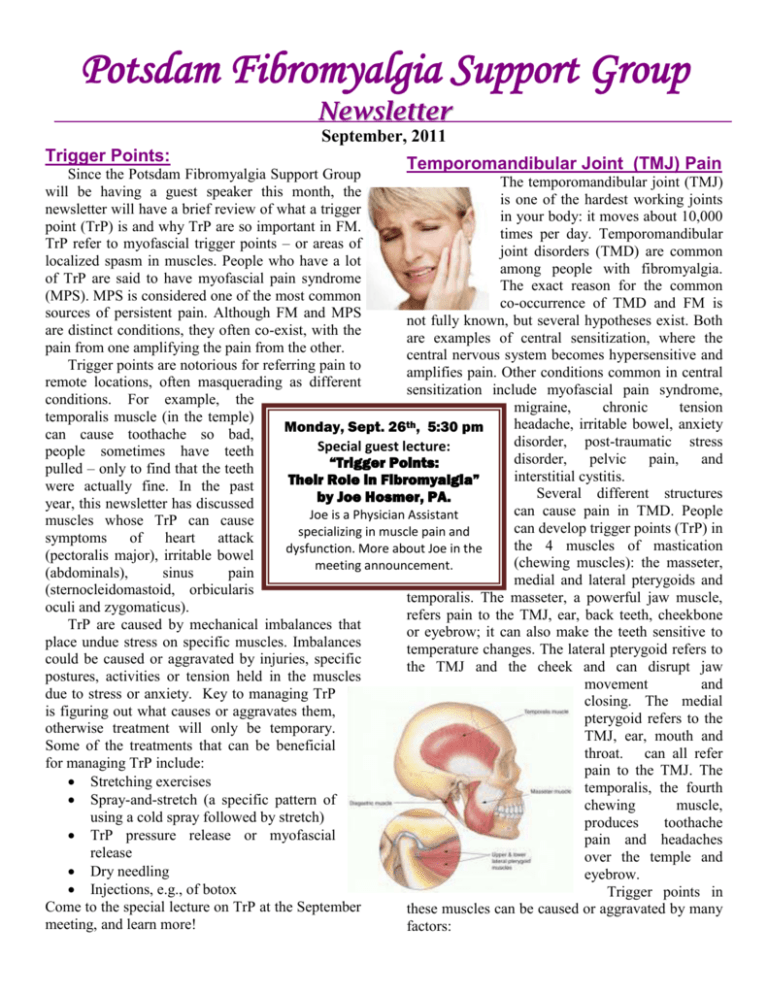
Potsdam Fibromyalgia Support Group Newsletter September, 2011 Trigger Points: Temporomandibular Joint (TMJ) Pain Since the Potsdam Fibromyalgia Support Group The temporomandibular joint (TMJ) will be having a guest speaker this month, the is one of the hardest working joints newsletter will have a brief review of what a trigger in your body: it moves about 10,000 point (TrP) is and why TrP are so important in FM. times per day. Temporomandibular TrP refer to myofascial trigger points – or areas of joint disorders (TMD) are common localized spasm in muscles. People who have a lot among people with fibromyalgia. of TrP are said to have myofascial pain syndrome The exact reason for the common (MPS). MPS is considered one of the most common co-occurrence of TMD and FM is sources of persistent pain. Although FM and MPS not fully known, but several hypotheses exist. Both are distinct conditions, they often co-exist, with the are examples of central sensitization, where the pain from one amplifying the pain from the other. central nervous system becomes hypersensitive and Trigger points are notorious for referring pain to amplifies pain. Other conditions common in central remote locations, often masquerading as different sensitization include myofascial pain syndrome, conditions. For example, the migraine, chronic tension temporalis muscle (in the temple) th headache, irritable bowel, anxiety Monday, Sept. 26 , 5:30 pm can cause toothache so bad, disorder, post-traumatic stress Special guest lecture: people sometimes have teeth disorder, pelvic pain, and “Trigger Points: pulled – only to find that the teeth interstitial cystitis. Their Role in Fibromyalgia” were actually fine. In the past Several different structures by Joe Hosmer, PA. year, this newsletter has discussed can cause pain in TMD. People Joe is a Physician Assistant muscles whose TrP can cause can develop trigger points (TrP) in specializing in muscle pain and symptoms of heart attack the 4 muscles of mastication dysfunction. More about Joe in the (pectoralis major), irritable bowel (chewing muscles): the masseter, meeting announcement. (abdominals), sinus pain medial and lateral pterygoids and (sternocleidomastoid, orbicularis temporalis. The masseter, a powerful jaw muscle, oculi and zygomaticus). refers pain to the TMJ, ear, back teeth, cheekbone TrP are caused by mechanical imbalances that or eyebrow; it can also make the teeth sensitive to place undue stress on specific muscles. Imbalances temperature changes. The lateral pterygoid refers to could be caused or aggravated by injuries, specific the TMJ and the cheek and can disrupt jaw postures, activities or tension held in the muscles movement and due to stress or anxiety. Key to managing TrP closing. The medial is figuring out what causes or aggravates them, pterygoid refers to the otherwise treatment will only be temporary. TMJ, ear, mouth and Some of the treatments that can be beneficial throat. can all refer for managing TrP include: pain to the TMJ. The Stretching exercises temporalis, the fourth Spray-and-stretch (a specific pattern of chewing muscle, using a cold spray followed by stretch) produces toothache TrP pressure release or myofascial pain and headaches release over the temple and Dry needling eyebrow. Injections, e.g., of botox Trigger points in Come to the special lecture on TrP at the September these muscles can be caused or aggravated by many meeting, and learn more! factors: Clenching or grinding the teeth, especially while sleeping. Stress. Dental work due to holding the mouth open for prolonged periods. Changes in dentition: having a tooth removed, a crown inserted, or dentures made or altered. Hypermobility of the jaw (the ability to fit more than 2 knuckles between your front teeth). Chewing gum, ice, pencils, etc. Poor neck posture, since the jaw is connected to the neck. Central sensitization or widespread pain The temporomandibular joint, itself, can also be the source of pain. The joint includes a disk, or connective tissue pad, that allows the pivoting and gliding motion necessary at the jaw. The disk can sublux, or slip out of place and slip back, leading to clicking or popping in the jaw. If the disk slips entirely out of place, it can also result in locking of the jaw – either locked open or stuck closed. When the disk slips out of place, it puts stress on the delicate connective tissue holding it in place, causing inflammation and sharp pain. Just like the meniscus in the knee, the disk in the TMJ protects the joint. If the disk is damaged, the joint is more likely to develop arthritis, accompanied by more diffuse, aching pain. The arthritic TMJ may develop a grinding sound and feel. Because so many different things may be going on in TMD, treatment needs to be specific to the specific contributing factors for each patient. In the case of TrP, the factors contributing to the TrP need to be addressed. The TrP can then be treated with stretches, heat, massage, myofascial release or relaxation training. If the disk is subluxing, the cause needs to be identified; it could be due to lateral pterygoid spasm (since that muscle pulls on the disk when you open the jaw). Exercises can improve function and alignment in the jaw. A physical therapist trained in treating the TMJ can help develop a customized program for you. A dentist can also make a splint (or ‘appliance’) to hold your jaw in a specific position to improve its function; splints are often worn only at night. We Need Volunteers with TMD If you have TMD and would like to find out what factors might be contributing to your pain, come work with Clarkson’s Physical Therapy students as they learn about TMD. The students are looking for 4-6 volunteers to do an interview and PT examination. If you have TMD, are interested and are available 10:30-11:30 am Friday, 10/14, contact Leslie at Lnrussek@clarkson.edu. Aquatic Fitness Class Resumes The regular adaptive aquatic exercise starts Tuesday, September 20th. Classes are Tuesday/Thursday 5:30-6:30 pm. Tracey Sharlow is back as the instructor, and the pool will be heated (hooray)! Many support group members have been regular participants in the aquatic program, so you may meet some old friends or make new ones. Contact the SUNY Potsdam Non-Credit Courses office at by phone at 267-2167 or on-line at www.potsdam.edu/community/noncredit/summer.cfm. September Potsdam Meeting: The September meeting of the Potsdam Fibromyalgia Support Group will be Monday, September 26th, at 5:30 pm. This will be a special guest lecture “Trigger Points: Their Role in Fibromyalgia” by Joe Hosmer, PA. Joe trained initially as a massage therapist, graduating from Central Ohio School of Massage in 1995. He returned to school to get a Masters Degree as a Physician Assistant from D'Youville College in 2009; his Master’s thesis was on Trigger Point Therapy. Starting this fall, he will be working as a PA, specializing in muscle pain and dysfunction, in Dr. Reason's new clinic in Gouverneur. Clarkson Hall, 59 Main St., Potsdam. For information about meetings, contact CPH Physical Therapy Department at 261-5460. Massena Meetings on Hold: The Massena Support Group is not meeting through the summer. For more information about the Massena group, please contact facilitator Maxine Dodge, at 7695778. This newsletter is a joint effort of Clarkson University and Canton-Potsdam Hospital. If you would prefer to receive these newsletters electronically, please send your email address to gilberta@clarkson.edu. You can access current and previous Potsdam Fibromyalgia Support Group Newsletters on our web site: www.people.clarkson.edu/~lnrussek/FMSG.


